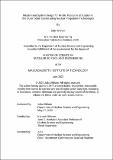Mission and System Design for In-Situ Resource Utilization in the Outer Solar System using Nuclear Propulsion Technologies
Author(s)
Julia Witham
DownloadThesis PDF (5.318Mb)
Advisor
Shirvan, Koroush
Terms of use
Metadata
Show full item recordAbstract
The parameter space of a theoretical in-situ propellant acquisition system is examined for a sample return mission from trans-Neptunian destinations (>40au) using two theoretical spacecraft designs, which compare nuclear propulsion systems for impulsive and continuous thrust. Each available propellant substance is compared in each propulsion system. Propellant acquisition systems are shown to be less advantageous overall for continuous thrust missions, where the system mass must remain well below the roughly 6 tons of additional propellant otherwise necessary to affect the return journey in 5 years.
While the spacecraft using impulsive thrust could return in 50 years with roughly equal propellant mass in a Hohmann maneuver, it required more than 70 tons of additional hydrogen propellant at launch to be capable of a comparable transit time to the electric spacecraft. For impulsive spacecraft, the optimal propellant mass for a return transit varies based on system and propellant characteristics. These optimal values are found for each scenario and each system. Even relatively inefficient (< 20 mL/kWh) acquisition systems were found to be constrained by propellant tank size. The low density of propellants such as liquid hydrogen had a pronounced impact on collection strategy and ultimate production capacity, such that propellant tank capacity became a valuable resource for a spacecraft.
Optimal parameters and collection goals for the propellant acquisition system are described for each potential destination, such that the mission time is minimized while making full use of the available propellant capacity. Among the available substances in the Kuiper belt, nitrogen propellants are the worst options in terms of mission time, propellant mass, and collection time requirements. Using raw methane as propellant instead of a source of hydrogen can offer significantly higher ∆V and lower total processing requirements in some scenarios. Hydrogen extraction from methane via pyrolysis presented the best overall performance for both propulsion systems.
Date issued
2023-06Department
Massachusetts Institute of Technology. Department of Nuclear Science and EngineeringPublisher
Massachusetts Institute of Technology